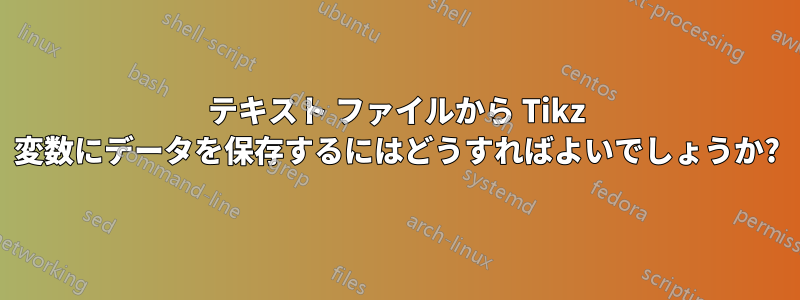
テキスト ファイルを使用して、Tikz プロットで使用している変数の値を渡そうとしています。データを文字列から文字に変換する方法がわかりません。ここでは、 はautomaton.txt各行にいくつかの配列値 (1x4) を文字列として保存し、それに基づいて を書き換えます\statedef。テキスト ファイルの行数はインポートごとに異なり、 は\def文字のみを受け入れます。また、テキスト ファイルを Overleaf に同期して、Overleaf の図に反映された変更を確認できる方法があるかどうか知りたいです。
\documentclass[tikz,border=1cm]{standalone}
\usepackage{graphicx} % Required for inserting images
\usepackage{amsthm}
\pdfoutput=1
\usepackage{multirow}
\usepackage{lettrine}
\usepackage{graphicx,float}
\usepackage{tikz}
\usetikzlibrary{automata, positioning, arrows.meta,calc,cd}
\usetikzlibrary{patterns}
\usetikzlibrary{datavisualization}
\tikzset{
->, % makes the edges directed
>=stealth, % makes the arrow heads bold
node distance=3cm, % specifies the minimum distance between two nodes. Change if necessary.
every state/.style={thick, fill=gray!10}, % sets the properties for each ’state’ node
initial text=$ $, % sets the text that appears on the start arrow
}
\usepackage[fleqn]{amsmath}
\usepackage{amssymb}
\usepackage{cite}
\usepackage{lettrine}
\let\labelindent\relax
\usepackage{enumitem}
\usepackage{multicol}
\usepackage{readarray}
\usepackage{pgfplots}
\usepackage{pgfmath}
\makeatletter
\newenvironment{customlegend}[1][]{%
\begingroup
% inits/clears the lists (which might be populated from previous
% axes):
\pgfplots@init@cleared@structures
\pgfplotsset{#1}%
}{%
% draws the legend:
\pgfplots@createlegend
\endgroup
}%
% makes \addlegendimage available (typically only available within an
% axis environment):
\def\addlegendimage{\pgfplots@addlegendimage}
\makeatother
\usepackage[T1]{fontenc}
\usepackage[export]{adjustbox}
\usepackage{booktabs,makecell}
\usepackage{graphicx}
\usepackage{xcolor}
\usepackage[labelsep=quad,indention=10pt]{subfig}
\usepackage{ifthen}
\begin{document}
\tikzset{
redfill/.code={
\definecolor{mycolour1}{rgb}{1,0,0}%
\pgfkeysalso{/tikz/fill=mycolour1!40}
}
}
\tikzset{
greenfill/.code={
\definecolor{mycolour2}{rgb}{0,1,0}%
\pgfkeysalso{/tikz/fill=mycolour2!30}
}
}
\tikzset{
bluefill/.code={
\definecolor{mycolour3}{rgb}{0,0,1}%
\pgfkeysalso{/tikz/fill=mycolour3!40}
}
}
\tikzset{
cyanfill/.code={
\pgfkeysalso{/tikz/fill=teal!60}
}
}
\tikzset{
twocolorfill/.style n args={2}{path picture={
\fill[#1] (path picture bounding box.south)--(path picture bounding box.north)--(path picture bounding box.north east)--(path picture bounding box.south east)--cycle;
\fill[#2] (path picture bounding box.south)--(path picture bounding box.north)--(path picture bounding box.north west)--(path picture bounding box.south west)--cycle;
}}
}
\tikzset{
threecolorfill/.style n args={3}{path picture={
\fill[#1] (path picture bounding box.east)--(path picture bounding box.north east)--(path picture bounding box.north west)--(path picture bounding box.west)--cycle;
\fill[#2] (path picture bounding box.center) -- (path picture bounding box.south) arc [start angle=-90, delta angle=-90, radius=1] -- cycle;
\fill[#3] (path picture bounding box.center) -- (path picture bounding box.south) arc [start angle=-90, delta angle=90, radius=1] -- cycle;
}}
}
\tikzset{
fourcolorfill/.style n args={4}{path picture={
\fill[#1] (path picture bounding box.east)--(path picture bounding box.north east)--(path picture bounding box.north)--(path picture bounding box.center)--cycle;
\fill[#2] (path picture bounding box.center)--(path picture bounding box.north)--(path picture bounding box.north west)--(path picture bounding box.west)--cycle;
\fill[#3] (path picture bounding box.center)--(path picture bounding box.south)--(path picture bounding box.south west) -- (path picture bounding box.west) -- cycle;
\fill[#4] (path picture bounding box.center)--(path picture bounding box.south)--(path picture bounding box.south east) -- (path picture bounding box.east) -- cycle;
}}
}
\tikzset{
colorfill1_sub/.code=
{
\ifnum\pgfkeysvalueof{/tikz/colorfill_item}=#1
\tikzset{greenfill}
\else
\fi
},
colorfill2_sub/.code=
{
\ifnum\pgfkeysvalueof{/tikz/colorfill_item}=#1
\tikzset{redfill}
\else
\fi
},
colorfill3_sub/.code=
{
\ifnum\pgfkeysvalueof{/tikz/colorfill_item}=#1
\tikzset{bluefill}
\else
\fi
},
colorfill4_sub/.code=
{
\ifnum\pgfkeysvalueof{/tikz/colorfill_item}=#1
\tikzset{cyanfill}
\else
\fi
},
hashfill1_sub/.code=
{
\ifnum\pgfkeysvalueof{/tikz/colorfill_item}=#1
\tikzset{pattern=north west lines, pattern color=black}
\else
\fi
},
fourcolor1_sub/.code=
{
\ifnum\pgfkeysvalueof{/tikz/colorfill_item}=#1
\tikzset{fourcolorfill={cyanfill}{redfill}{greenfill}{blue!50}}
\else
\fi
},
threecolor1_sub/.code=
{
\ifnum\pgfkeysvalueof{/tikz/colorfill_item}=#1
\tikzset{threecolorfill={cyanfill}{greenfill}{blue!50}}
\else
\fi
},
twocolor1_sub/.code=
{
\ifnum\pgfkeysvalueof{/tikz/colorfill_item}=#1
\tikzset{twocolorfill={blue!50}{cyanfill}}
\else
\fi
},
colorfill_item/.initial=0,
colorfill/.code n args={9}
{
\tikzset{colorfill_item=#1,colorfill1_sub/.list=#2,colorfill2_sub/.list=#3,colorfill3_sub/.list=#4,colorfill4_sub/.list=#5,hashfill1_sub/.list=#6,fourcolor1_sub/.list=#7,threecolor1_sub/.list=#8,twocolor1_sub/.list=#9}
}
}
\begin{figure*}[h]
\centering
\begin{adjustbox}{minipage=\textwidth,scale=0.8}
\begin{tikzpicture}[node distance = 2cm, on grid,>={Stealth[inset=0pt,length=6pt,angle'=28,round]}
]
\begin{customlegend}[legend style={at={(10,-8)},anchor=south},legend columns=-1,legend style={column sep=1ex},legend entries={Proposed Method,PCM PTA-MPC,CB PTA-MPC,PTA-MPC,Failed State}]
\addlegendimage{black,only marks, mark=*, cyanfill,style={scale=4}}
\addlegendimage{black,only marks, mark=*, bluefill,style={scale=4}}
\addlegendimage{black,only marks, mark=*, greenfill,style={scale=4}}
\addlegendimage{black,only marks, mark=*, redfill,style={scale=4}}
\addlegendimage{black,only marks, mark=*, pattern=north west lines, pattern color=black,style={scale=4}}
\end{customlegend};
\readarraysepchar{,}
\readdef{automaton.txt}{\mydata}
\readarray\mydata\datacell[-,\ncols]
\def\test{\pgfkeysvalueof{\mydata[3,4]}}
%% DO NOT put extra space below!!!
%% {first state xcoor,first state ycoor,first state superscript, last state superscript}
%% State Definition
\def\statedef{{2,0,2,10},{8,2,11,14},{8,-2,15,20},{8,-4,21,24},{4,-3,25,26},{5,-6,27,29}}
%% {first state superscript, last state superscript}
%% Straight Edge Definition
\def\straightsolidedge{{1,5},{7,9},{11,12},{14},{15,20},{21,24},{27,29}}
\def\bendrightsolidedge{{2,25},{25,27},{29,22},{24,19},{18,9},{16,7},{4,15},{4,21},{16,23}}
\def\bendleftsolidedge{{12,7},{14,9}}
%% Color Definiton
\def\rstates{{5,22,23,24,25,27,28,29}}
\def\gstates{{11,12}}
\def\bstates{{13}}
\def\cstates{{17,18,19,20}}
\def\hashedstates{{6,10,13,26}}
\def\bicolorstates{{15,16}}
\def\tricolorstates{{7,8}}
\def\quadcolorstates{{2,3,4}}
\node[state,initial,fourcolorfill={cyanfill}{redfill}{greenfill}{blue!50}](q1){$q^{1}$};
\foreach \e in \statedef
{\edef\mye{{\e}}
\pgfmathsetmacro{\myx}{\mye[0]}
\pgfmathsetmacro{\myy}{\mye[1]}
\pgfmathsetmacro{\myfirstind}{\mye[2]}
\pgfmathsetmacro{\mystartind}{int(\mye[2]+1)}
\pgfmathsetmacro{\mylastind}{\mye[3]}
\node [state, colorfill/.expanded={\myfirstind}{\gstates}{\rstates}{\bstates}{\cstates}{\hashedstates}{\quadcolorstates}{\tricolorstates}{\bicolorstates}] at (\myx,\myy) (q\myfirstind){$q^{\myfirstind}$};
\foreach \a[evaluate=\a as \b using int(\a-1)] in {\mystartind,...,\mylastind}{
\node[state, right of=q\b, colorfill/.expanded={\a}{\gstates}{\rstates}{\bstates}{\cstates}{\hashedstates}{\quadcolorstates}{\tricolorstates}{\bicolorstates}] (q\a){$q^{\a}$};
}
}
\foreach \r in \straightsolidedge
{\edef\myr{{\r}}
\pgfmathsetmacro{\mystartstate}{\myr[0]}
\pgfmathsetmacro{\myendstate}{\myr[1]-1}
\foreach \d[evaluate=\d as \e using int(\d+1)] in {\mystartstate,...,\myendstate}{
\draw (q\d) edge (q\e);
}
}
\foreach \t in \bendrightsolidedge
{\edef\myt{{\t}}
\pgfmathsetmacro{\f}{\myt[0]}
\pgfmathsetmacro{\g}{\myt[1]}
\draw (q\f) edge[bend right] (q\g);
}
\foreach \u in \bendleftsolidedge
{\edef\myu{{\u}}
\pgfmathsetmacro{\h}{\myu[0]}
\pgfmathsetmacro{\i}{\myu[1]}
\draw (q\h) edge[bend left] (q\i);
}
\draw (q4) edge[bend left] node [below left]{} (q11);
\end{tikzpicture}
\end{adjustbox}
\end{figure*}
\end{document}
また、以下は の内容ですautomaton.txt。
2,0,2,5
2,2,6,8
2,-2,9,11
答え1
を使用しますlualatex。私のアプローチはあまりエレガントではないことを認めます :P。
\documentclass{scrartcl}
\usepackage{luacode}
\usepackage{pgffor}
\begin{filecontents*}{data.txt}
2,0,2,6
2,2,6,8
2,-2,9,11
\end{filecontents*}
\begin{document}
\begin{luacode}
function read_file(file,macro)
f = io.open(file, "r")
concat_string = ""
i = 1
for line in io.lines(file) do
concat_string = concat_string .. "{" .. line .. "},"
i = i + 1
end
-- remove trailing ","
concat_string = concat_string:sub(1,-2)
tex.sprint("\\def" .. "\\" .. macro .. "{" .. concat_string .. "}")
end
\end{luacode}
\directlua{read_file("data.txt", "statedef")}
\noindent
\foreach \s [count=\i from 1] in \statedef{%
State \i{} entries:
\foreach \se in \s {%
\se~
}
\\
}
\end{document}
答え2
おそらく、配列の行と列を反復処理するためのネストされたループが役に立つでしょう。expl3 には\cs_to_str:N、制御シーケンス トークンの名前を確実に提供するルーチンである が含まれているため、次の MWE には expl3 構文を使用することにしました。
\begin{filecontents*}{MYRENAMEDautomaton.txt}
2,0,2,5
2,2,6,8
2,-2,9,11
1\TeX1,2\TeX2,3\TeX3,4\TeX4
\end{filecontents*}
\documentclass{article}
\usepackage{readarray}
\ExplSyntaxOn
\cs_new:Npn \TwoDArrayToMacro #1#2 {
\group_begin:
\nocheckbounds
\Mostafa_TwoDArrayToMacroLoop:nnnnnnnn {#1}{#2}{1}{1}{}{}{}{}
}
\cs_new:Npn \Mostafa_TwoDArrayToMacroLoop:nnnnnnnn #1#2#3#4#5#6#7#8 {
% #1 array
% #2 macro
% #3 row number
% #4 column number
% #5 row separator
% #6 column separator
% #7 rows gathered
% #8 colum in construction
\int_compare:nNnTF {#3}>{\use:c{\cs_to_str:N #1ROWS}}
{\group_end: \cs_set:Npn #2{#7}}{
\int_compare:nNnTF {#4}>{\use:c{\cs_to_str:N #1COLS}}
{
\exp_after:wN \use_ii_i:nn \exp_after:wN {
\exp_after:wN {
\exp:w\exp_after:wN\exp_after:wN\exp_after:wN\exp_end:
\int_eval:n{(#3)+1}
}
}{\Mostafa_TwoDArrayToMacroLoop:nnnnnnnn{#1}{#2}}{1}{,}{}{#7#5{#8}}{}
}
{
\exp_after:wN \use_ii_i:nn \exp_after:wN {\exp_after:wN {
\exp:w \Mostafa_exp_args_otimes:nNn{4} \use_ii_i:nn {#1[#3,#4]}{\exp_end: #8#6}
}}
{
\exp_after:wN \use_ii_i:nn \exp_after:wN {
\exp_after:wN {
\exp:w\exp_after:wN\exp_after:wN\exp_after:wN\exp_end:
\int_eval:n{(#4)+1}
}
}{\Mostafa_TwoDArrayToMacroLoop:nnnnnnnn{#1}{#2}{#3}}{#5}{,}{#7}
}
}
}
}
\cs_new:Npn \Mostafa_exp_args_otimes:nNn #1#2#3 {
\exp_after:wN\use_ii_i:nn\exp_after:wN{\exp_after:wN{\exp:w
\exp_after:wN \__Mostafa_exp_args_otimes:nn\exp_after:wN {\exp_after:wN}
\tex_romannumeral:D \int_eval:n {(#1)*1000}~d #3}}{#2}
}
\cs_new:Npn \__Mostafa_exp_args_otimes:nn #1#2 {
\__Mostafa_exp_args_otimes:n {#2}{#1\exp_end:}{\__Mostafa_exp_args_otimes:nn{#1#1\exp_after:wN}}
}
\cs_new:Npn \__Mostafa_exp_args_otimes:n #1 {
\__Mostafa_exp_args_otimes:wnw #1{\use_i:nn}d{\use_ii:nn}dd
}
\cs_new:Npn \__Mostafa_exp_args_otimes:wnw #1d#2#3dd{#2}
\ExplSyntaxOff
\begin{document}
\readarraysepchar{,}
\readdef{MYRENAMEDautomaton.txt}{\mydata}
\readarray\mydata\datacell[-,\ncols]
\TwoDArrayToMacro{\datacell}{\statedef}
\ttfamily\selectfont \frenchspacing
\noindent
\verb|\statedef|=\\
\meaning\statedef
\end{document}




